Cultivating Loyalty: 8 Client Retention Strategies for Long-Term Business Success

Sorry, there were no results found for “”
Sorry, there were no results found for “”
Sorry, there were no results found for “”
As you build your customer base, you may fall into one common trap: allocating all your resources to attract new customers while taking your existing ones for granted!
But, according to research published by Harvard Business Review, acquiring a new client can cost up to 25 times more than retaining an existing one! That’s one of the reasons why you shouldn’t surrender your hard-earned clients to competitors without a fight.
The most successful businesses tend to have a balanced focus on both customer acquisition and retention. But how do you keep clients engaged and loyal? 🤔
In this article, we’ll go through eight effective client retention strategies to ensure that your business is able to maximize customer lifetime value. We will also dive into key customer retention metrics to track the success of your strategies.
Bonus: We’ll share some cutting-edge features within ClickUp, a CRM tool for sustainable business growth. They’ll help you boost sales and develop stronger customer relationships in no time.
The concept of client retention is pivotal in business strategizing. It’s all about a company’s ability to continue selling its products or services to existing clients and prevent them from turning to competitors.
Every company wants its buyers to become repeat customers. However, customer retention strategies are beneficial and essential for survival and growth in certain types of businesses. Some examples include:
Client retention is more than a profitability exercise.
Retaining customers requires fewer resources than acquiring new ones—plus, on average, existing clients are likely to spend 31% more on your business than new clients, directly increasing your revenue.
Over time, you gain clients’ trust. They may even develop an emotional attachment to your brand or product, which leads to a greater willingness to purchase more or upgrade.
Here’s an overview of the six different ways in which client retention benefits your business:
Effective customer retention strategies revolve around creating value, building relationships, ensuring client satisfaction, and encouraging their ongoing commitment to your business. Use the following eight strategies to make it happen:
Consistently delivering high-value products or services and fulfilling client commitments is a cornerstone for long-term business success. It impacts your brand reputation as well as client retention.
Here are some practical tips to help you gain loyal customers through excellence:
Using a comprehensive project management platform like ClickUp can go a long way in maintaining quality and reliability.
ClickUp Milestones and ClickUp Goals can help set up and track key customer deliverables in terms of both quality and quantity. Set measurable standards for your team so that your products and services are perfected before they reach the client. 🌸
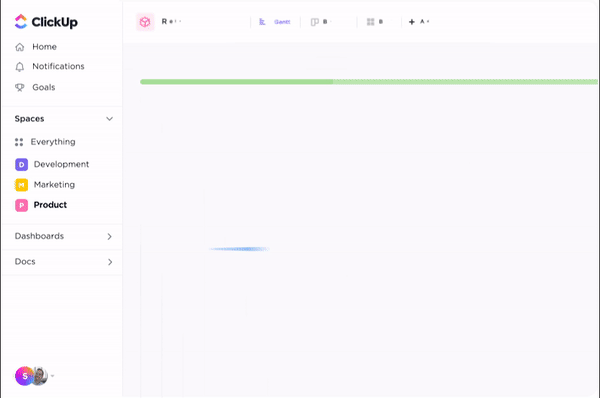
You can also create checklists and subtasks to ensure your internal processes meet the set standards. This structured approach makes it easier to account for and manage all project areas effectively. Use ClickUp’s process improvement templates to reduce inefficiencies and redirect resources toward activities that enhance the quality of your products or services.
For example, the ClickUp PDCA (Plan, Do, Check, and Act) Process Whiteboard Template is an excellent tool to visualize processes and find opportunities to enhance customer satisfaction.
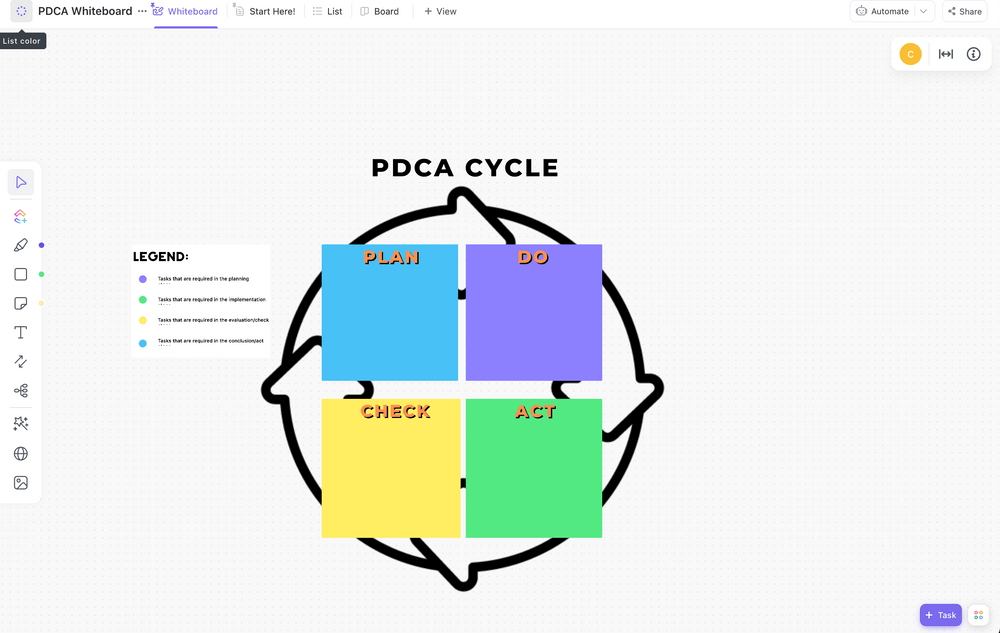
This customer retention strategy is rooted in the understanding that every client is unique. When you tailor your services to meet each client’s specific needs and preferences, you:
With ClickUp, you can customize every client account to reflect unique workflows. The platform’s numerous custom views, such as the Gantt and List views, give you fresh insights into a customer’s transaction history and pattern. Leverage Custom Fields, custom statuses, and templates to create personalized project plans and tasks that cater to each client’s specific demands.

For instance, you’re trying to impress a customer with faster delivery logistics. In this case, you can use Reminders and time tracking estimates within ClickUp for precise deadline tracking and time management.
You can make your business stand out by going beyond customers’ basic expectations for your products or services. Additional value can include industry insights, educational content, or advice besides the core commodity you offer. Your customers will appreciate the extra effort, which could position your business as a valuable resource partner.
In practice, a value-addition strategy might involve:
Looking to develop technical or educational materials for clients? ClickUp Docs allows you to create and share top-grade professional content. Set up elaborate guides, tutorials, or support documents and organize them in a structured way within the tool. If you’re selling software, you can also record your screen to create easy-to-follow video tutorials using Clip for additional support!
ClickUp offers a variety of templates for creating customer-facing documents, saving you time and ensuring consistency in the materials you produce. Additionally, ClickUp AI can assist you in the writing process by:

Implementing an omnichannel communication strategy involves integrating your communication tools and channels so that information flows seamlessly between them. It’s super important to provide robust customer service, as you need to ensure the conversation started on one channel can be continued on another without loss of context.
Ideally, if you establish a presence on multiple communication platforms where your clients are active, they can reach you through their preferred methods. You should also establish a way to track client issues and requests across channels.
Maintaining multiple communication platforms can be challenging, but we have a solution! Leverage ClickUp’s 1,000+ integrations, including those with tools like Slack, Microsoft Teams, and email, to centralize customer correspondence.
Additionally, you can use the Comment and Chat view features to organize all client-related communications within ClickUp. ClickUp AI can also bring you up to speed by summarizing threads and improving the speed and quality of your customer service in the process.
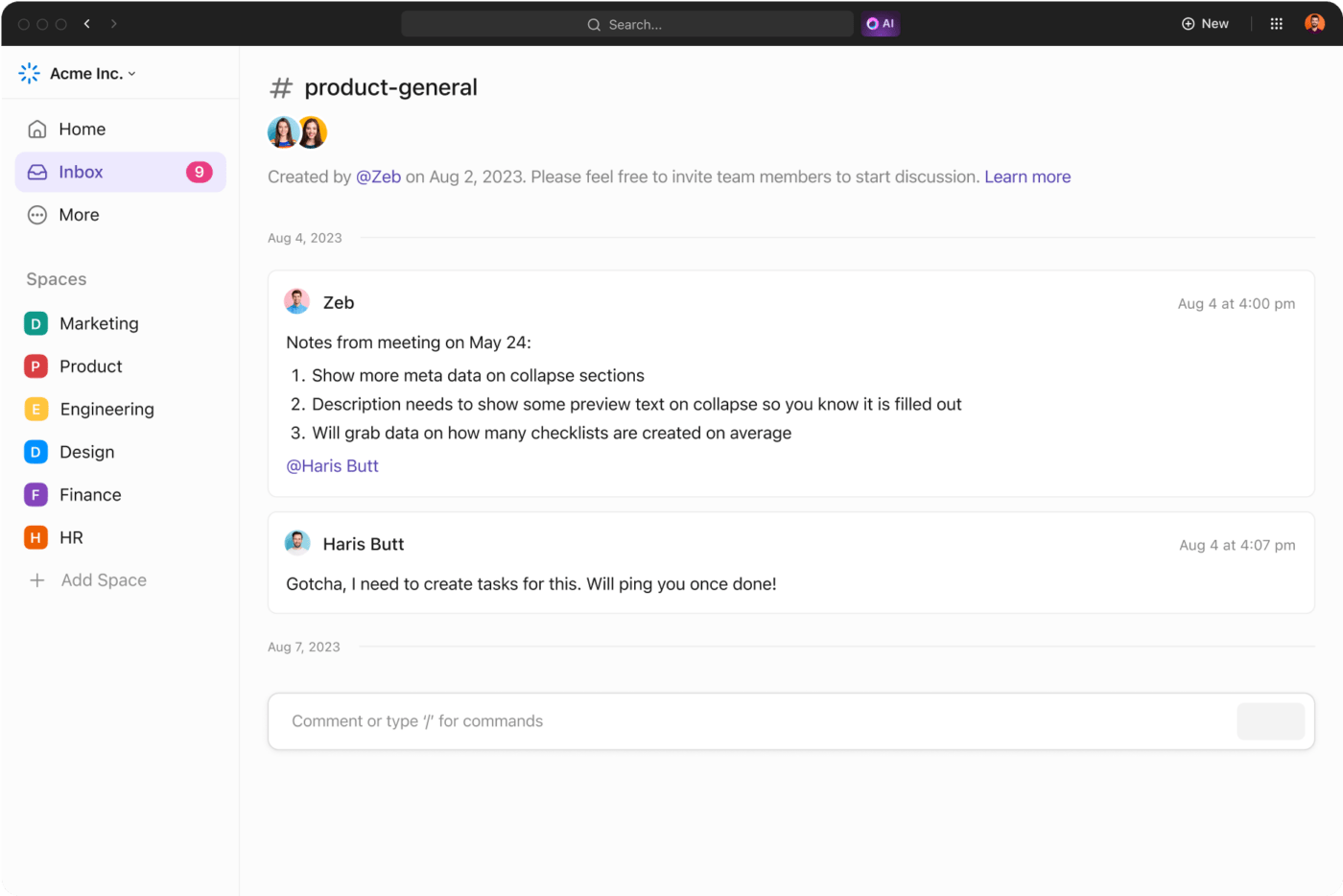
A customer loyalty program or incentive encourages repeat business by rewarding clients for their continued support. These programs can potentially increase the frequency of purchases and strengthen the buyer’s emotional connection with the brand. There are several types of loyalty incentives you can launch, such as:
As an all-in-one project management solution, ClickUp can significantly streamline the management of your loyalty incentives. First, you should create dedicated Lists or Folders for your active loyalty programs. Each client can have a task or list where you track their eligibility for rewards and the rewards already given.
You can use Board or Table views to visually represent where each client stands in your loyalty program, making it easier to manage and track progress.
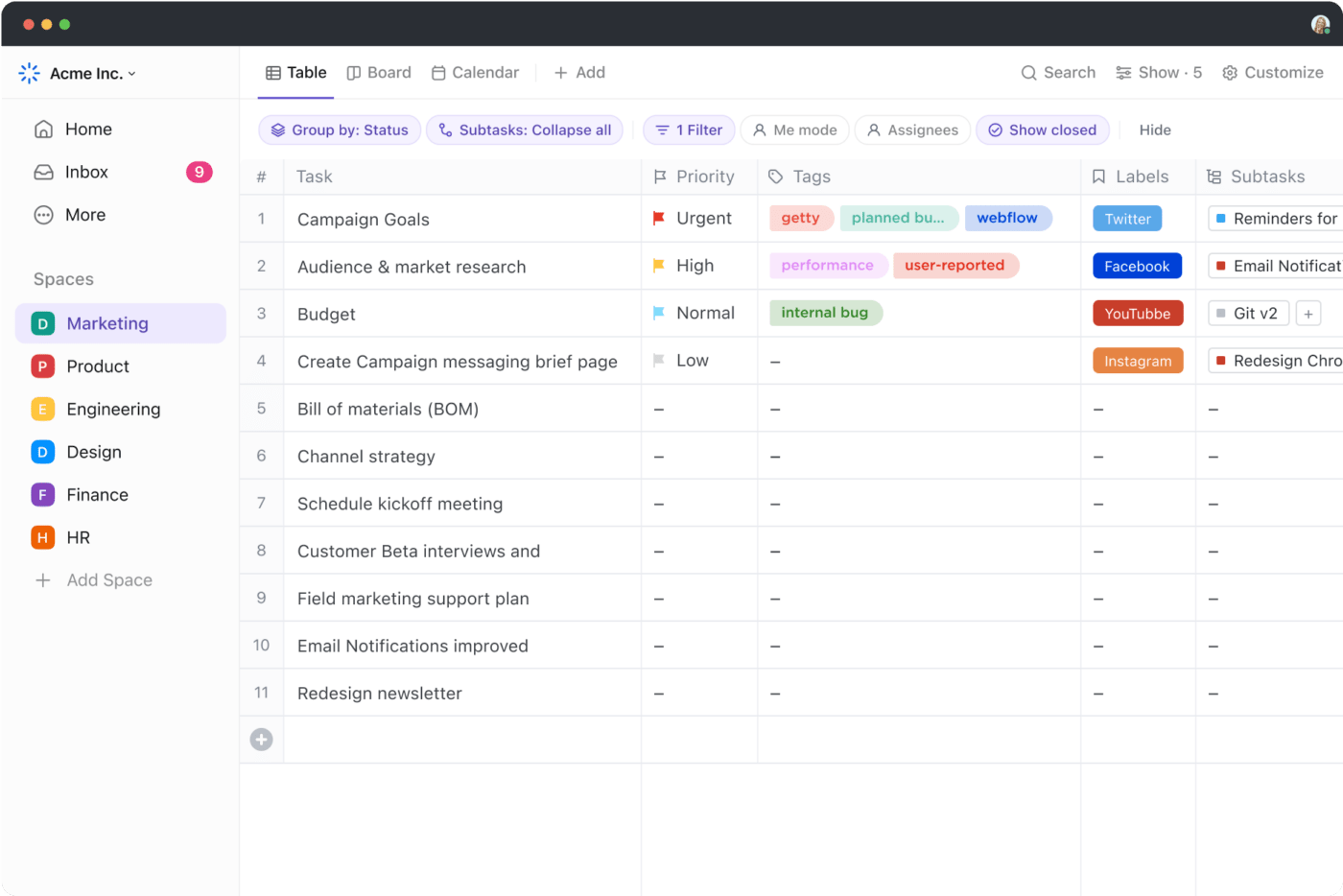
Next, set up ClickUp Automations to trigger reminders or actions when a client reaches a milestone, qualifying them for a loyalty reward.
Proactively identifying and addressing issues before they escalate enhances customer satisfaction and loyalty. It demonstrates that client concerns are important and that the business is committed to resolving them. Here are some practical tips to implement this strategy:
Custom Dashboards in ClickUp are an easy way to stay on top of client issues and the status of resolutions. You can add cards that display tasks in progress, upcoming deadlines, workload distribution, and more. For example, you can customize a card to detect unevenly distributed work that can lead to bottlenecks and quality issues.
You can set up notifications and alerts for when tasks go off track. This ensures that potential issues are brought to your attention promptly.

Regularly collecting client feedback can reveal new industry trends, client preferences, or emerging needs, guiding the development of more market-friendly products or services.
A customer feedback loop is a process where a business asks for feedback, listens to what clients say, makes changes based on that feedback, and then tells the clients what has been changed. Involving clients in the feedback process can foster community, giving them a stake in your business’s success and growth.
To effectively gather customer feedback, businesses can use:
You can set up customizable ClickUp Forms to collect feedback from your clients. Each response will automatically create a task in ClickUp, so you’ll have all your customer feedback neatly organized in one place. You can assign them Custom Statuses, such as New Feedback, Under Review, Action Taken, and Resolved.
As you start implementing changes based on this feedback, you must track the progress of the recommended actions—completing the tasks closes the loop.

Building a relationship involves creating and nurturing a deeper, more meaningful bond with your client. It’s not just about staying in touch but actively empathizing with their unique needs and offering a thoughtful solution.
Here’s what it means in practice:
Memorizing every detail about every client is impossible, but fortunately, ClickUp is here to help. You can use ClickUp Docs and comments to document interactions with clients, including meeting notes, calls, and email summaries.
The platform offers a selection of customer profile templates to store personalized information about each client. They help you tailor your approach and brainstorm original ways to keep your client pool satisfied.
ClickUp’s Calendar view and Reminders ensure you don’t forget your client’s important dates, meetings, and planned check-ins.

Client retention (or lack thereof) significantly impacts a business’s long-term health. If you want the full picture of customer loyalty and satisfaction, tracking metrics like customer churn and retention rates is essential. Here’s how both compare:
| Parameter | Customer Churn Rate | Customer Retention Rate |
| Definition | Measures the percentage of customers who stop doing business with a company over a specific period | Measures the percentage of customers a business manages to retain over a specific period |
| Calculation | (Number of customers lost during the period ÷ Number of customers at the start of the period)*100 | [(Total customers at end of the period – New customers during the period) ÷ Total customers at start of the period]*100 |
| Example | If you started the year with 100 customers and lost 5 of them by the end of the year, your annual churn rate would be 5% | If you had 100 customers at the start of the year, lost 5, but gained 10 new customers, your retention rate would be 95% |
| Desirable Outcome | Low—A lower churn rate indicates better customer retention and satisfaction | High—A higher retention rate indicates strong customer loyalty and business stability |
| Measures | How many customers a business is losing | Customer loyalty and success in retention efforts |
| Importance | Indicates satisfaction and service quality, as well as impacts revenue and growth | Indicates customer loyalty and engagement, providing revenue predictability to an extent |
Both metrics are complementary and share this relationship:
Churn Rate = 100% – Retention Rate
Client retention is an extensive set of processes. They cannot be handled manually, so you need digital tools and platforms to track, manage, and enhance client relationships. With the right client retention software, you enjoy:
ClickUp is a robust work management platform that offers a whole suite of capabilities for client retention, building relationships, and much more.
For instance, you can use its diverse views, like the List, Board, or Table view, to monitor ongoing projects, client communication, and any specific retention efforts in a visually intuitive and organized manner.
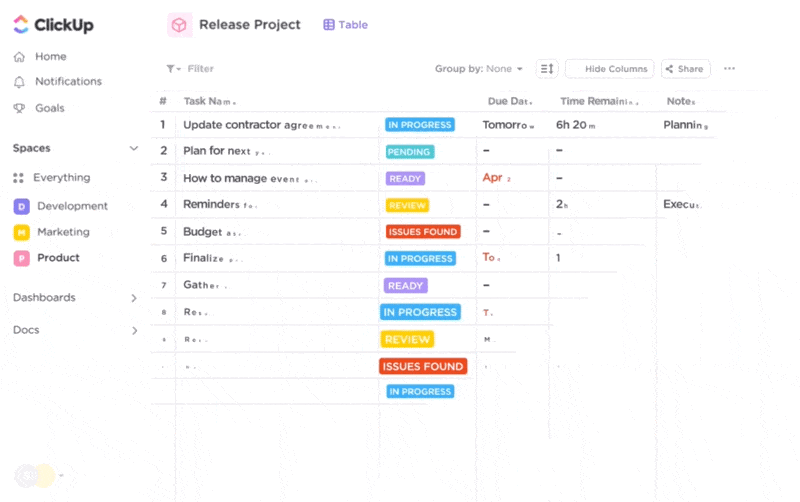
Within ClickUp’s CRM Suite, you’ll find a wealth of tools to build a client database. Its pre-designed CRM templates are tailored to organize client information effectively and track client interactions, all customizable to your needs. Capture essential information, such as contact details, preferences, and key milestones, and keep everything organized in neat Folders.
Additionally, ClickUp’s task management system can be tailored to every client retention activity, whether it’s follow-up calls, satisfaction surveys, or special client engagement initiatives. It also has an integrated Sales Suite where you can manage leads and oversee sales pipelines with ease.
Customizable ClickUp Automations can trigger actions like sending thank-you emails, scheduling meetings, or updating client status, all contributing to a streamlined retention process.

ClickUp’s native reporting tools provide insights into key customer retention metrics, sales performance, and team productivity. These analytics are crucial for understanding the effectiveness of your strategies and making data-driven decisions.
Client retention depends on understanding and fulfilling customer expectations, needs, and preferences. ClickUp emerges as a powerful ally in applying client retention strategies to your everyday CRM, admin, and communication workflows.
By incorporating ClickUp into your retention efforts, you can ensure a more connected, responsive, and client-focused approach—sign up for free and check it out for yourself! 🌞
© 2025 ClickUp